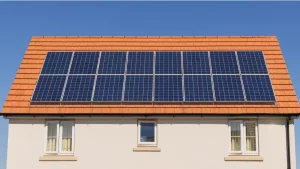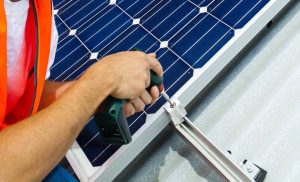Flexible solar panels that can be installed anywhere
In the United States, they plan to implement Project Nexus, which involves the installation of solar power plants over canals. The concept was born from a 2021 study at UC Merced and UC Santa Cruz that proved a number of benefits of installing solar panels over open water channels.
“Solar channels are an example of an energy-water connection that offers many sustainability benefits. Using water channels as photovoltaic plants saves water with renewable electricity generation and avoids taking up large tracts of land for solar energy development,” said Dr. Brandi L. McQueen, lead author of the study.
See also: A floating solar power plant from 1.4 million solar panels was launched at a Chinese fish farm
The Turlock Irrigation District (TID) has entered into a partnership agreement with the Department of Water Resources (DWR), Solar Aqua Grid, and UC Merced on a $20 million project funded by the State of California. The project will include an energy storage system to explore how storage can support the local electrical grid when solar generation is not optimal due to adverse weather conditions.
By shading California canals, Solar Aqua Grid developers also hope to stop evaporation, as is done in Europe and India, where similar systems are already in use.
“Research and common sense tell us that in an era of increasing drought, it’s time to end evaporation,” said Jordan Harris, CEO of Solar Aqua Grid Now is your chance to test this knowledge.”

The growing demand for renewable energy sources is encouraging scientists to look for new areas to install solar panels, in addition to the usual rooftops, ground-based solar farms and lakes.
Researchers at the University of California, Santa Cruz have suggested that authorities place canopies with photovoltaic cells over water channels that supply the region with fresh water. This approach will not only generate electricity, but also reduce the intensity of water evaporation.
If such solar canopies were installed on 6,400 km of open canals in California, the scientists calculated, it would save the state 295 billion liters of water annually. “That would be enough to irrigate 20,000 hectares of agricultural land or meet the needs of more than two million people,” says project participant Brandi McQueen.
In California and other southern states, the problem of saving fresh water is especially acute, in particular because of frequent droughts. And every year, due to climate change, the situation worsens, so McQueen’s idea looks quite attractive. By the way, India already has similar solar channels, according to Clean Technical.
In India, the situation is aggravated by the fact that it is quite difficult to find a free site for the construction of a solar station on land due to overcrowding and the high cost of land. Therefore, the government of Gujarat, which has a high population density (441 people per sq. km.).
approved the project of placing steel structures with solar panels above irrigation canals. This solution has four advantages at once: it produces electricity, saves land, reduces water evaporation and reduces carbon dioxide emissions. The pilot project was launched in 2012.
The German company Sinn Power plans to start deliveries to the market of a modular design of a floating power plant of its own architecture. It can combine energy generation from three sources at once – solar, wind and wave energy. The total power of one farm reaches 140 kW.
The US Embassy in Tajikistan reports that this solar power plant will be the largest in Tajikistan and the highest in the world. The project also includes a 180-kilowatt-hour hybrid storage power plant.

In Murgha, one of the world’s highest mountain communities, more than 6,000 people have been isolated from Pamir Energy’s power supplies and the national power grid due to difficult terrain at an altitude of 3,600 meters.
USAID is helping Tajikistan achieve its clean energy goals, as well as providing sustainable power to remote communities and building the capacity of Tajik energy companies to build and operate renewable energy power plants.
One such firm is P4P Energy of Carbondale, Colorado. It was created by Stephen and Marie Catherine Conger in 2010. The main innovative product of the company is flexible solar panels that combine the properties of an energy converter and a carrier element.
The development is characterized by low weight, versatility, and unusual design. Such panels can be stretched as a canopy over any space. All that is needed for their installation is a few supports, to which the edges of the flexible solar modules will be fixed. Installation of the structure is quick and simple and therefore cost-effective.
P4P Energy has already created several canopies from its stretched solar panels over water channels in India. These structures not only provide electricity to local communities, but also create a shadow that prevents water from evaporating. In addition, P4P Energy carports are used in India and the United States for car parks.
It is assumed that such solar panels can be pulled over the railway tracks, as well as along them. Due to their high energy efficiency, electric trains require relatively little energy. For example, according to official U.S. Electric Rail Efficiency Metrics.
a 300W solar panel is enough to transport one person 3,000 to 11,000 kilometers per year, or 8 to 30 kilometers per day. In comparison, the same amount of energy allows a Chevrolet Bolt electric car with one driver to travel 7.24 km per day.
For every mile (1.6 km) of railroad tracks, tensile solar panels with a total capacity of 1 to 3 MW can be placed. This is enough to provide the transport network with energy for 3–10 million passenger-kilometers per year. Thus, the installation of solar panels along the railroad will help supply electricity from the Sun to all US electric trains, or at least most of them.

